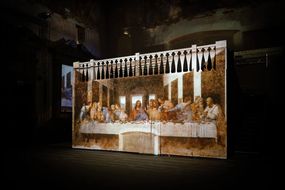From 24 November to 3 March 2024
The MAN museum in Nuoro presents a new project dedicated to an ideal dialogue between past and present, between classic and contemporary, in line with an exhibition philosophy that for years has led to reflections on the eternal return of universal themes in the art of all times. After the major exhibitions already reserved for Alberto Giacometti and the archaic (in collaboration with the Giacometti Foundation of Zurich) or Picasso and the myth, in the famous series of engravings for the Vollard Suite, the MAN intends to investigate the connection which, after centuries, connects the spatial research of Lucio Fontana with the value of space in Giotto's compositions, together with the highly symbolic presence of the color gold in his reification of the infinite and elsewhere.
In the Byzantine and medieval Western pictorial tradition, the desire to represent a real, three-dimensional space progressively weakens. The gold background of mosaics and painted panels offers a deep and vibrant shine and gives the pictorial composition, mostly sacred, an aura of religiosity and mystery, capable of establishing the indissoluble bond between art and faith. The painting is an icon to be adored and takes on a symbolic value, alluding to eternal and transcendent values. Gold is not color, but a divine symbol, it exalts the figures, hieratic and two-dimensional, without humanizing them, it abstracts them from the real context, isolating them in time and space and places them within rigid fixed patterns, canceling every custom and every relationship with everyday life: no expression and movement, no familiar landscape, no recognizable building, no comparison with experience. A new sense of reality and space, true and profound, emerges in medieval art thanks to the personality of Giotto (ca. 1267-1337 ), which his contemporaries were already praising because he «changed the art of Greek into Latin and reduced it to the modern», as Cennino Cennini wrote in his Book of the Art. The sacred and golden space, two-dimensional and transcendent, a curtain of light that isolates from the external world of the previous tradition, is "pierced" by Giotto, in search of a third dimension, profound and real.
The gold background becomes a real sky, atmospheric, bright and clear on spring days, illuminated by the light of the moon and stars (and even comets) in the dark night. Giotto discovers how painting can depict what the eye sees, he understood the possibility of illusion, wonderfully experienced for the first time in the two famous fake choirs of the Scrovegni chapel in Padua. Here, at the beginning of the fourteenth century, even before the invention of Renaissance perspective, Giotto introduced the idea of trompe-l'oil, of painting capable of transforming space and creating illusionistic environments. A space without figures and in which – without warning – the outside world bursts in. The two fine, empty rooms could be animated by singers at any moment. And, from the Gothic mullioned window, you could see the swallows circling in the air, from the eaves of the nearby Eremitani church, as Roberto Longhi wrote in 1952.

Via Sebastiano Satta, 27, Nuoro, Italy
Opening hours
| opens - closes | last entry | |
| monday | Closed now | |
| tuesday | 10:00 - 19:00 | |
| wednesday | 10:00 - 19:00 | |
| thursday | 10:00 - 19:00 | |
| friday | 10:00 - 19:00 | |
| saturday | 10:00 - 19:00 | |
| sunday | 10:00 - 19:00 |

From 9 June to 5 October 2025
Da Vinci Experience

Cathedral of the Image, Florence

Artsupp Card: museum + exhibitions 10.00 €